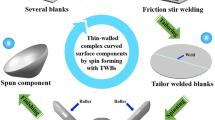Abstract
The stub end is used to connect pipes in piping arrangement. Generally the components are manufactured by welding two subcomponents. But this method requires a large amount of time and money and also has a problem due to welding process like thermal deformation or embrittlement at heat affected zone. The spinning process, eco-friendly incremental process, was adopted to develop stub end without weld. It allows the component to be produced by non-welding with low cost and short process time. The major goal of this study is to develop optimum spinning process for manufacturing integrated stub end in keeping with the dimensions presented in the code. The suitable multi-step spinning process and rollers which can set required shapes and dimensions at each location of the component were designed by simulation. Base on the result of analysis and test, the 4 inch’s stub end specified in the code was developed. The spinning machine was also developed to manufacture specimens. Hardness was measured to predict the strength of flange part. Along with the shapes, all dimensions at each part were satisfied the required values.
Similar content being viewed by others
References
Kim, J. S., Cho, J. R., and Jeong, H. S., “Manufacturing Method of Long-Neck Flange,” KOR Patent, No.100688066, 2007.
Kastuteru, A., “Manufacturing Method of Lap-Joint Pipe,” JP Patent, Shou64-71527, 1989 (in Japanese).
ASME, “Factory-Made Wrought Buttwelding Fittings,” ASME B16.9, 2007.
Jeong, H. S., Son, C. W., Oh, J. S., Choi, S. K., and Cho, J. R.., “Friction Welding Process Analysis of Piston Rod in Marine Diesel Engine and Mechanical Properties of Welded Joint,” Transactions on Materials Processing, vol. 20, no. 3, pp. 236–242, 2011.
Park, H. W., Kwon, J. H., Kim, J. S., and Cho, J. R.., “The Development of Manufacturing Method of Integrated Lap Joint by Spinning Process,” Proc. of the Korean Society for Technology of Plasticity Spring Conference, pp. 163–166, 2010.
Park, J. E., Han, C. S., Choi, S., Kim, S. S., and Na, K. H., “The Spinnability of Multi-step Cylindrical Cup in Spinning Process,” Proc. of KSPE Spring Conference, pp. 1016–1020, 2001.
Kang, J. S., Park, G. S., and Kang, E. S., “Design of Hydraulic & Control System for the Disc Spinning Machine,” J. Korean Soc. Precis. Eng., vol. 19, no. 9, pp. 157–165, 2002.
Lee, H. W., Hwang, D. W., Song, S. A., and Kim, C., “A Study on the Improvement of Hot Spinning Process for Weight Lighting of CNG Vessel (Type II),” Proc. of KSPE Spring Conference, pp. 135–136, 2012.
Jeong, D. S., Kim, S. T., Choi, D. B., Ye, S. B., and Seol, S. S., “A Study on the Thermal Characteristics of Spindle for the Spinning Machine,” Proc. of KSPE Spring Conference, pp. 565–569, 2005.
Kim, Y. H., Park, J. W., and Cho, H. S., “An Analysis of Tube Spinning for Shock Absorber on Vehicles,” J. Korean Soc. Precis. Eng., vol. 17, no. 3, pp. 33–38, 2000.
Author information
Authors and Affiliations
Corresponding author
Rights and permissions
About this article
Cite this article
Gwak, GY., Jeon, JW., Cho, JR. et al. Development of integrated stub end by spinning process. Int. J. Precis. Eng. Manuf. 16, 1473–1477 (2015). https://doi.org/10.1007/s12541-015-0195-x
Received:
Revised:
Accepted:
Published:
Issue Date:
DOI: https://doi.org/10.1007/s12541-015-0195-x



